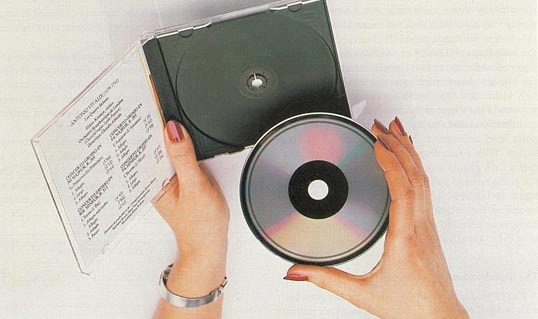When the technical development of the Compact Disc was virtually completed in 1981, the packaging and marketing activities were started. And since the CD was a totally different product from the LP, a completely new packaging had to be designed. Numerous ideas were considered; samples were made, discussed, tested and rejected. It was difficult to find the 'ideal' packaging, because consumer acceptance would be a decisive factor when the CD was introduced. Some designs at first looked promising, but proved to be unusable because of problems in mass production.
Because of its sensitive surface, it was necessary to package the CD in such a way that it would be fully protected against damage. The package also had to provide space for a booklet, and of course automatic assembly was another important requirement.

Product development teams at PolyGram in Germany and the Netherlands worked intensively to find a solution. Glass, wood, plastic and many other materials were tried, but none of them met all the demands. The designers themselves had decided that the ideal packaging should not be much thicker than the CD itself, and it also had to present the consumer with the image of a state-of-the-art product. Price was another important factor, because the packaging had to be affordable. In other words, it was clear that the switch from LP to CD was nothing less than another industrial revolution!
Peter Doodson, working for the Philips Design in Eindhoven was therefore asked to come up with some new ideas. This led to a three-piece package made of plastic (polystyrene). Samples were made and everyone involved in the project reacted with enthusiasm. The next step was to transform the idea into a form that was suitable for mass production, which meant that tools were for production by means of injection molding. One problem arising at that time was how the tool for the tray, with its center clamping of the disc, had to be designed, because injection molding technology still had many limitations at that time. The process was tested, modified and tested again and again until it worked.
The moment of truth arrived when the first samples were taken out of the injection-molding machine. But the product proved to be virtually perfect, which gave rise to the name 'Jewel Case'! However not everyone was so positive about the new and untried Jewel Case. Tests by consumer panels revealed that not everyone knew immediately how to open the case. And the more firmly it was held, the more difficult it became to open it. The only solution was to teach consumers how to do it. Which helped, because after a few months the complaints disappeared.
Numerous variants of the Jewel Case have been designed during the last twenty years. Containing single and double trays, transparent and colored trays, rotating trays and even trays with raised spindles. But the original Jewel Case remained the world standard for the packaging of CDs. Many billions of cases have been produced since 1982, and recently output has even reached as many as eight billion a year!
At first the Jewel Case weighed 100 grams, had thick walls and didn’t break. However, due to severe competition manufacturers reduced its weight to 68 grams. As a result easy breakage became synonymous for the Jewel Case. After the introduction of DVD, which required a different center hub, Philips decided to completely redesign the Jewel Case and named it Super Jewel Box. This Super Jewel box is now mainly used for SACS discs.
